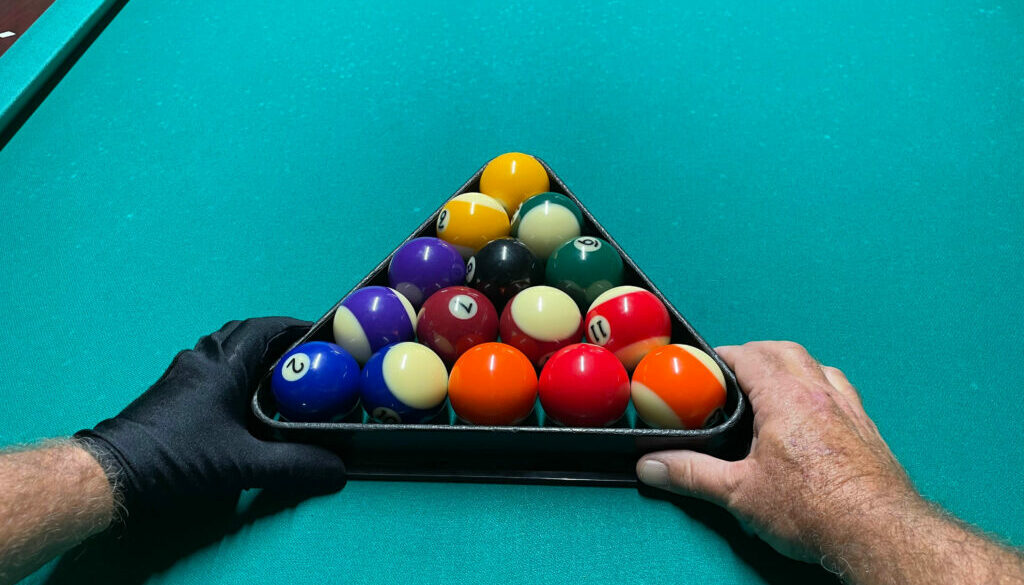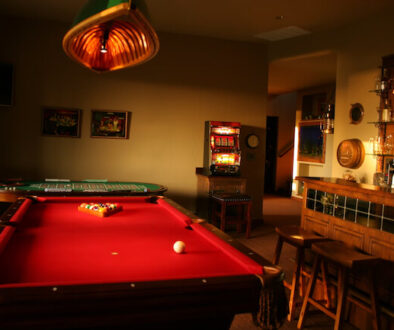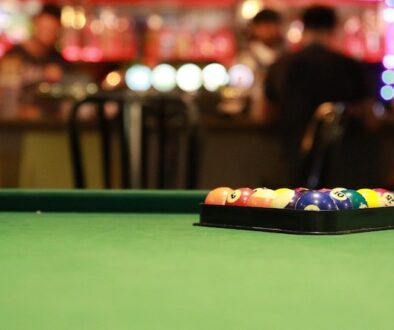How to Rack Pool Like a Boss: A Pool Ball Setup Guide
Contrary to popular opinion, the way you rack pool balls matters. Arranging pool balls on the table correctly is one of the most overlooked aspects of the sport. In this article, we’ll explain why racking is important, ways to rack different games, and different methods of racking balls.
Let’s get to it!
What is Racking in Pool?
Racking pool balls simply means placing the object balls in the right spot on the pool table before starting a game. It’s the first step when setting up for any game of pool, and you have to do it before hitting the break.
Racking rules differ between different pool games such as 8 ball or 9 ball. But the goal is always to create a fair rack and as tight of a rack as possible to ensure an optimal break shot.
Why is racking necessary?
Racking pool balls ensures you have all the balls required for the game you are playing. It also allows you to get a game started. Racking also makes it easier to ensure you have the right balls in the right spot on the table for the respective game.
Proper racking will save players time and make sure the game gets off to a good start.
The biggest benefit of racking pool balls correctly and tightly is ensuring you get a good spread for the break shot. When the balls are spread out, it’s much easier to potentially complete a run out, and make all your balls quickly.
Types of Pool Racks
Pool racks typically come in two standard configurations or shapes; triangle and diamond. Triangle racks are suitable for any pool game that requires 15-object balls, while the diamond rack is used for 9 ball pool.
Traditionally, racks are made from plastic or wood. Wooden racks are often made of maple, mahogany or walnut. Other rack materials include aluminum and carbon fiber.
Besides these traditional racks, there is also a modern variation called template racks. Template racks are made from a thin material, typically less than 0.14 mm thick. They also have cut-outs meant to keep the balls in precise spots.
The most popular template racks in pool are the Accu-Rack and Magic Rack.
Here are the benefits of using template racks:
- More consistent racking
- Creates a tighter rack
- Makes racking easier in general
- Template racks take up less room when storing
When using a template rack, you leave it in place during the break. But, leaving it on the table means it can interfere with ball roll during slow breaks. For this reason, template racks aren’t for everybody, as some people prefer a more natural ball roll.
Some competitions and tournaments may prohibit players from using template racks, so it’s essential to check the rules before playing just to be sure.
How to Rack Pool Balls
When it’s time to setup your pool balls, the main goal is to get the rack as tight as possible to give yourself a better chance to blast balls all over the table. When you rack the balls, make sure there is no debris or imperfections on the pool table’s cloth before racking.
Racking requires you to follow specific rules depending on the game. The type of rack you are using and the number of balls also matter.
Below, we look at more specific racking rules depending on the particular game.
8 Ball Racking
You will need a triangle rack to set up an 8-ball game. You will rack all 15 numbered balls. For this article, we will be focusing on the American variation of 8 ball (with solid colored and striped object balls).
How to set up 8-ball:
- Place the 1 ball on the apex (top) of the rack over the foot spot marked on the pool table
- Place a solid ball at one of the corners and a striped ball on the other
- Place the black 8 ball at the center of the rack – in the third row from the apex
- Spread the remaining balls randomly in the rack, ensuring no predictability
9 Ball Racking
You need the diamond-shaped rack to set up a 9 ball game. It may take a little more effort to get a tight rack if you use a triangle rack. You will rack the object balls numbered 1-9, and the 9 ball is the only stripe.
When breaking, 9 ball rules require every shot to hit the ball with the lowest numerical value first (the 1 ball).
How to set up 9-ball:
- Place the 1 ball at the top of the rack and over the foot spot on the table
- Place the 9 ball at the center of the diamond rack – between the 2 balls on the third row from the top
- Distribute the remaining balls randomly within the rack
10 Ball Racking
10 ball is easy to set up as there are no complicated rules. You will need a triangle rack and object balls numbered 1-10.
How to set up 10-ball:
- Place the 1 ball at the top of the rack
- Place the 2 ball and 3 ball on the bottom left and right corners
- Place the 10 ball at the center of the rack – the 3rd row from the top
- Distribute the remaining balls randomly within the rack
Straight Pool Racking
For straight pool, or 14:1 continuous pool, you will need a triangle rack and 15 object balls. Some players have different ways of racking in straight pool, but the basics are the same.
How to set up straight pool:
- Place the triangle rack over the table with the top corner over the foot spot
- Place the 1 ball or any other ball you use as the apex directly over the foot spot – it doesn’t matter what ball you choose
- Distribute the other 14 balls randomly in the rack
Straight Pool re-racking: When you finish the first rack in straight pool (pocket 14 balls), the 15th ball is only re-racked if it is inside the rack. Otherwise, only the 14 balls that were pocketed are re-racked.
How to Make Tight Racks in Pool
The rack quality can affect your overall performance when playing pool. If you don’t make the rack tight enough, the break may result in balls that are all bunched up. In pool, you want the balls to be spread out.
Steps to making a tight rack:
- Slide the racked balls back and forward, lining up the the top ball with the foot spot marker on the table
- Slide your fingers over the side of the rack and push the balls forward with your thumbs and palms until no gaps are showing
- Remove your hands slowly, carefully lifting the rack from the table
This process will take some practice, but once you get it down, it’s just like riding a bike.
What to Avoid When Racking Pool Balls
Some players will use illegal practices like pattern racking and ball gapping to gain an unfair advantage during games. These are two things you want to avoid.
You can often get away with these illegal practices when playing for fun, but they can have serious consequences in tournament or league play.
Pattern racking means arranging the balls following an intentional or purposeful pattern. WPA rules prohibit this and require all balls to be placed randomly (except the center ball, and the 2 and 3 ball in 10-ball). Breaking this rule in a tournament can lead to disqualification.
Ball gapping is similar to pattern racking, but instead of placing balls in a specific pattern, you purposely place gaps in certain positions in the rack. This can potentially give the player an advantage, as they may be able to predict where the balls in particular positions will go.
Wrap Up
Making a tight rack is a winning strategy when playing any game of pool because it increases the chances of a more open table after the break. This makes it easier to run out balls.
Each game of pool has specific rules for arranging the object balls when racking. Some games, like 8-ball, 10-ball and straight pool, use a triangle rack. Others, such as 9-ball, use a diamond rack.
Knowing how to arrange the balls according to the game’s rules is always the first step. Mastering how to make the rack as tight as possible is the most important one.
Like everything else in billiards, you will get good at it over time as you rack balls over and over. So keep practicing and sharpening your racking skills!
For more information beyond just racking, feel free to check out our 8 ball vs 9 ball, and 9 ball vs 10 ball articles.
As always, Happy Shooting!



